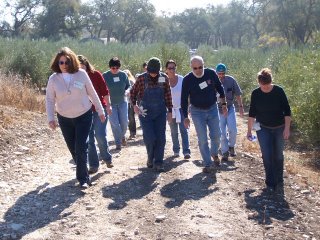Saturday, January 06, 2007
The day's collection
This was the fruit of our labor. :)
We picked more than the group of first graders that had toured and picked the day before, but less than an experienced set of pickers. (The ranch foreman had to send a set of pickers in after we left to really clear the trees.)
Buried in the tree
This is one of my fellow pickers wearing the bucket while pushing herself as far into the branches as she can to get her olives.
Friday, January 05, 2007
Collection bucket
This is the bucket into which most of the olives are picked during the harvest. It's usually worn with straps that hang over one's back so the bucket is always right in front of you like a baby in a sling. As the olives fall into it, regardless of how gently one tries, the olives hitting the bottom must bruise a little bit, so I'm wondering if they would be improved by cushioning the bottom or filling it with an inch or two of water.
Tuesday, January 02, 2007
A knowledge sampling of French Oil/Vinegar
In order to provide as much assistance as I can to one of my colleagues, below I've provided a smattering of some of the websites I've visited to acquire knowledge of some of the French oils and vinegars we sell:
French Regional Specialties and Cuisine
A great encyclopedia on a wine site
If you're investigating vinegar, investigate the wine it comes from: a wine site describing Banyuls and Maury
Among all the mistranslations there are still clues in France's wikipedia entry on Huile d'Olive
Practically Edible, another good food encyclopedia has some collections of olive entries with a nice list of French olives and links to each.
Again, lots of mistranslations I'm sure, but who really talks about olive oil more than the Italian Wikipedia.
Given that the European Union is now the main regulating body, this PDF file from the Directorate-General of Agriculture has helpful info.
I'll try to be more helpful as time goes on.
French Regional Specialties and Cuisine
A great encyclopedia on a wine site
If you're investigating vinegar, investigate the wine it comes from: a wine site describing Banyuls and Maury
Among all the mistranslations there are still clues in France's wikipedia entry on Huile d'Olive
Practically Edible, another good food encyclopedia has some collections of olive entries with a nice list of French olives and links to each.
Again, lots of mistranslations I'm sure, but who really talks about olive oil more than the Italian Wikipedia.
Given that the European Union is now the main regulating body, this PDF file from the Directorate-General of Agriculture has helpful info.
I'll try to be more helpful as time goes on.
Sunday, December 31, 2006
The group gathers and treks

This is the group I referred to in the previous post "Friday." I was about to spend the day with them and learn so much beyond just olives and olive oil, including:
- Gegenbauer makes a red pepper vinegar that is supposed to be amazing.
- Testament for a shop called "Le Sanctuaire" in Santa Monica, which after further investigation I see Food & Wine Magazine raving "No other shop in America offers such a remarkable mix of ingredients, cookbooks, equipment and high design or is such a magnet for innovative chefs."
- I learn about a chef/owner of a bakery who is best friends with the owner of Gegenbauer
- I hear about the forest district of Austria, Waldviertel, and that if I love great food I have to visit it

Why I really wanted to be there

I've read about olive oil and it's various methods of being processed. I had some idea what the smell of an olive mill might be (surprise, it smells a lot like olive oil). Seeing oil flowing into a barrel for the first time, though exciting, I could visualize in my head. But seeing an olive or an olive tree, or feeling the resistance of an olive as it's plucked (well, milked is the more proper colloquialism) from the tree, or smelling the soil and feeling the texture of an olive leaf--I didn't have any book education on that or any connection with that through my sensory exploration of the world's olive oils. Everything I had read said that most of the quality of an olive oil is determined by how well the olives and the olive trees are treated. No matter how carefully picked or how quickly pressed or how well cleaned the press, if the olive one puts in the mill hasn't been raised well, the resulting olive oil won't be stellar. I knew Pasolivo's oil was stellar, so I was excited to experience the grove with my hands and nose and eyes.
By the way, the colloquialism is milking because you treat the branch of the olive tree like a teat, pulling gently from the top and squeezing at just the right pressure as you pull down so that the fruit will pop off as you pull (as well as a few leaves and branches which mainly get separated out later). No beating, no shaking, no shimmying of the tree and branches. In the end, the olive branch is giving you it's milk and should be treated with the care and respect of a mother's teat in order to give the best that it can.

Subscribe to:
Comments (Atom)






